Informational Concepts are passive entities which provide a way to link the operational side of an organization to its business goals and the products (through behavior entities) that it offers to its customers.

In the Metamodel above, you can see that:
- The contract entity is a kind of business object (passive structure)
- Meaning is associated with business object
- Representation realizes a business object
- Value is associated with a product
- Products aggregate business service
- For example: The Business actor plays certain role to perform a business process for a business object as shown in the following generic archimate diagram.
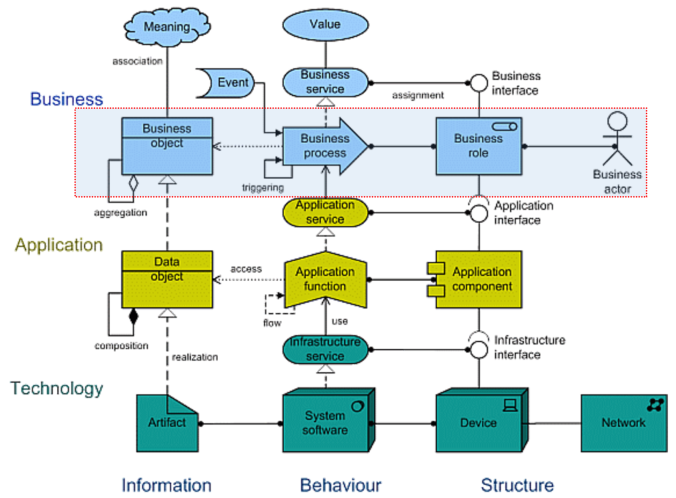
The ArchiMate standard also classifies the product concept itself, together with the related contract concept, as informational concepts.
Informational Concepts In contrast to the structural and behavioral concepts, which are mainly concerned with the operational perspective of an enterprise, the informational concepts focus on the “intentional” perspective.
Information Concept Notation
| Business object | A passive element that has relevance from a business perspective. |  |
| Representation | A perceptible form of the information carried by a business object. |  |
| Meaning | The knowledge or expertise present in a business object or its representation, given a particular context. |  |
| Value | The relative worth, utility, or importance of a business service or product. |  |
| Product | A coherent collection of services, accompanied by a contract/set of agreements, which is offered as a whole to (internal or external) customers. |  |
| Contract | A formal or informal specification of agreement that specifies the rights and obligations associated with a product. |  |
Business Object Notation
Business objects represent the important “informational” or “conceptual” elements in which the business thinks about a domain.

Business objects are passive in the sense that they do not trigger or perform processes and also has the following characteristics:
- A business object is therefore used to model an object type, such as, a UML class, of which several instances may exist within the organization.
- Business objects represent actual instances of information produced and consumed by behavior elements such as business processes.
- A business object could be used to represent information assets that are relevant from a business point of view and can be realized by data objects.
Business Object Example: The Archimate Diagram below shows:

- A business object Invoice, which aggregates (multiple) business objects Invoice line.
- Two possible realizations of this business object exist: an Electronic invoice (data object) and a Paper invoice (representation).
- The business process Create invoice creates the invoice and the invoice lines, while the business process Send invoice accesses the business object Invoice.
Representation Notation
Representations are the perceptible carriers of information that are related to business objects, for example, messages or documents.

The name of a representation is preferably a noun and have the following characteristics:
- A representations can be classified in various ways; for example, in terms of medium (electronic, paper, audio, etc.) or format (HTML, ASCII, PDF, RTF, etc.).
- A single business object can have a number of different representations. Also, a single representation can realize one or more specific business objects.
Representation Notation
The ArchiMate Diagram below shows:
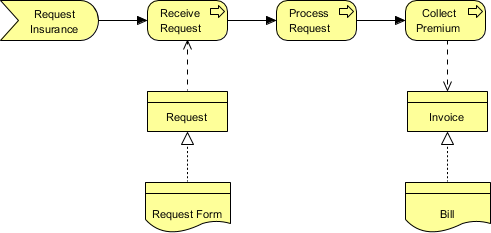
- The business object Request for insurance, which is realized (represented) by a (physical) request form.
- The Invoice business object is realized (represented) by a paper bill.
Meaning Notation
Meaning is defined as the knowledge or expertise present in a business object or its representation, given a particular context, which can be associated with a representation that carries this meaning. The name of a meaning should preferably be a noun or noun phrase.

It is possible that different users view the informative functionality of a business object or representation differently. For example, what may be a “registration confirmation” for a client could be a “client mutation” for a CRM department (assuming for the sake of argument that it is modeled as an external user). Also, various different representations may carry essentially the same meaning. For example, various different documents (a web document, a filled-in paper form, a “client contact” report from the call center) may essentially carry the same meaning.
Meaning Example
The ArchiMate Diagram below shows:
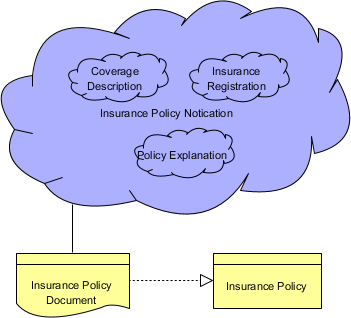
An Insurance policy document that is the representation of an Insurance policy, which is a business object.
The meaning related to this document is the Insurance policy notification, which consists of:
- a Policy explanation
- an Insurance registration
- a Coverage description.
Representation vs Meaning
A representation may realize one or more business objects. A meaning can be associated with a representation that carries this meaning.
Meaning vs Value vs Representation
- A meaning is the information-related counterpart of a value
- A meaning is a description that represents the intention of a business object or representation
Value Notation
Value is defined as the relative worth, utility, or importance of a business service or product and they have the following characteristics:
- A value can be associated with product and, indirectly, with the business services they are part of, and the roles or actors that use them.
- Value may apply to what a party gets by selling or making available some product or service

Value Example
In the ArchiMate Diagram below shows:
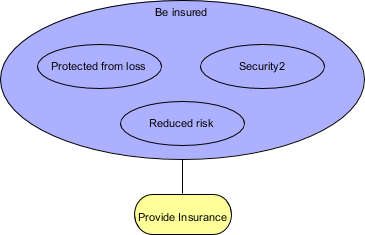
- The value Be Insured is the highest-level expression of what the service Provide Insurance enables the client to do
- three “sub-values” are distinguished that are part of what Be Insured amounts to.
Product Notation
A product is defined as a coherent collection of services, accompanied by a contract/set of agreements, which is offered as a whole to (internal or external) customers. The name of a product is usually the name which is used in the communication with customers, or possibly a more generic noun (e.g., “travel insurance”).

Product Example
The ArchiMate example below shows:
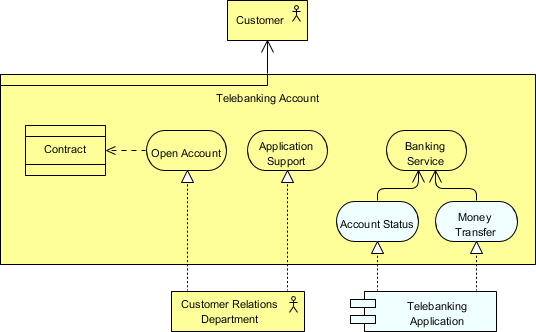
- A bank offers the product Telebanking account to its customers.
- Opening an account as well as application support (i.e., helpdesk and the like), are modeled as business services realized by the Customer relations department.
- As part of the product, the customer can make use of a banking service which offers application services realized by the Telebanking application, such as electronic Money transfer and requesting Account status.
Product vs Business Services vs Contract vs Value
- A product may aggregate business services or application services, as well as a contract.
- As mentioned above, a value can be associated directly with product and, but indirectly, with the business services they are part of the roles or actors that use them.
Contract Notation
A contract is defined as a formal or informal specification of an agreement that specifies the rights and obligations associated with a product. A contract is a specialization of a business object.

- The contract concept may be used to model a contract in the legal sense, but also a more informal agreement associated with a product.
- It may also be or include a Service Level Agreement (SLA), describing an agreement about the functionality and quality of the services that are part of a product.
Contract Example
The contract concept may be used to model a contract in the legal sense, but also a more informal agreement associated with a product. It may also be or include a Service Level Agreement (SLA), describing an agreement about the functionality and quality of the services that are part of a product. A contract is a specialization of a business object.
The ArchiMate Diagram below shows below:
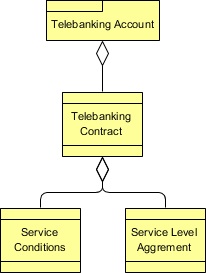
Diagram Interpretation
- A Telebanking contract associated with the product Telebanking account.
- The contract consists of two parts (subcontracts): the Service Conditions and a Service Level Agreement.
Other ArchiMate Resources: